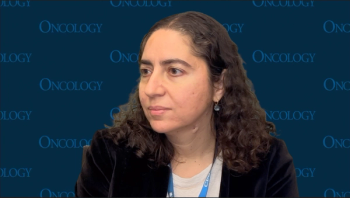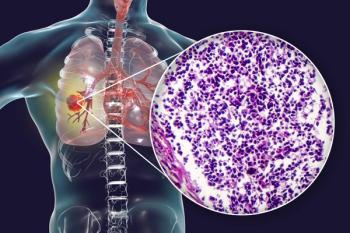
Early Efficacy Seen With Gedatolisib-Based Therapies in Prostate/Breast Cancers
Gedatolisib showed promising ORRs when given in combination with darolutamide and trastuzumab biosimilar in mCRPC and mBC, respectively.
Preliminary results from 2 clinical trials showed that gedatolisib-involving combinations demonstrated efficacy in metastatic castration-resistant prostate cancer (mCRPC) and HER2-positive metastatic breast cancer, according to a press release from the developer, Celcuity.1
Results came from 2 early-phase trials. The first was a phase 1/2 trial (NCT06190899) that evaluated the efficacy, safety, and pharmacokinetics of gedatolisib in combination with darolutamide (Nubeqa) in mCRPC. The second was a phase 1/2 trial (NCT06190899) that evaluated the efficacy, safety, and pharmacokinetics of gedatolisib in combination with trastuzumab-pkrb (Herzuma) in HER2-positive metastatic breast cancer that progressed after 2 or more HER2-directed chemotherapies.
Gedatolisib, a multitarget inhibitor, targets all 4 class I PI3K isoforms and the mTOR complexes mTORC1 and mTORC2, inducing a comprehensive blockade of the PI3K/AKT/mTOR pathway.
Gedatolisib Plus Darolutamide in mCRPC
At the preliminary phase 1 data cutoff of May 30, 2025, the 6-month radiographic progression-free survival (PFS) rate was 66%. Regarding safety, no grade 3 hyperglycemia was reported, though stomatitis was observed in 10.5% of patients (n = 4), with 7.5% (n = 3) being grade 2 and 2.6% (n = 1) being grade 3. No dose reductions were required with either gedatolisib or darolutamide, and no patients discontinued treatment due to a treatment-related adverse effect. Additional results for the phase 1 portion of the trial will be shared at a medical conference this year.
The trial enrolled a total of 38 patients with mCRPC, all of whom were randomly assigned to receive 600 mg of darolutamide twice daily with either 120 mg of gedatolisib or 180 mg of gedatolisib. All patients also received prophylactic treatment for stomatitis.
The phase 1 portion of the trial was amended to enroll up to 6 patients in each of 3 trial arms that will be treated with different doses. Following phase 1, up to 40 more patients will be randomly assigned to up to 4 phase 1b cohorts to determine the recommended phase 2 dose (RP2D); these dose levels will be decided based on the results from the phase 1 portion of the trial. Up to 18 patients will be enrolled so that a total of approximately 30 patients will be treated with the RP2D in the phase 2 dose expansion study. All patients will receive standard doses of darolutamide.
“We are very encouraged by these preliminary efficacy and safety data. The 66% 6-month radiographic progression-free survival rate for this novel combination therapy compares favorably with published data for androgen receptor inhibitors in this setting,” stated Igor Gorbatchevsky, MD, chief medical officer of Celcuity, in the press release.1 “With no treatment-related discontinuations and less than 3% of patients experiencing grade 3 stomatitis, we believe it is important to explore additional dose options for gedatolisib.”
Gedatolisib Plus Trastuzumab Biosimilar in Metastatic Breast Cancer
Results from this phase 2 investigator-sponsored clinical trial were shared at the
At the data cutoff of February 10, 2025, the confirmed objective response rate (ORR) was 43.2% (95% CI, 28.3%-59.0%), with 2 complete responses (5%), 17 partial responses (39%), 18 instances of stable disease (43%), and 5 instances of progressive disease (11%). With a median follow-up of 32.05 months, the median PFS was 6.0 months (95% CI, 5.03-7.69) and the median overall survival was 24.7 months (95% CI, 17.28-not available).
Regarding safety, any-grade treatment-related adverse effects (TRAEs) occurred in 95.5% of patients, with TRAEs of grade 3 or higher occurring in 22.7%; TRAEs led to dose adjustment of gedatolisib in 20.5%. The most common any-grade TRAEs were oral mucositis (90.9%), nausea (40.9%), skin reaction (38.6%), and hyperglycemia (25.0%); the most common grade 3 or higher TRAEs were oral mucositis (15.9%), skin reaction (6.8%), anorexia (2.3%), and hyperglycemia (2.3%).
The trial enrolled a total of 44 patients with unresectable locally advanced or metastatic HER2-positive breast cancer who received 8 mg/kg of intravenous trastuzumab-pkrb as a loading dose in cycle 1 and then at 6 mg/kg intravenously once every 3 weeks; gedatolisib was administered at 180 mg on days 1, 8, and 15 of each 3-week cycle. It was noted that no prophylaxis was given for stomatitis.
The median number of prior anti-HER2 therapies was 4 or more, with 86% of patients receiving at least 3 prior anti-HER2 therapies.
“The 43% ORR reported in patients who received at least 3 prior lines of anti-HER2 treatment for their disease is very encouraging and compares favorably to published data for other available therapies in this group of patients,” said Gorbatchevsky.1 “The regimen was well tolerated, and no patients discontinued gedatolisib due to TRAEs. While additional clinical studies are needed, these data suggest gedatolisib in combination with HER2-targeted therapy may be an effective and well-tolerated therapeutic option for patients with HER2-positive [metastatic breast cancer].”
References
- Celcuity reports clinical data from two early phase studies of gedatolisib. News release. Celcuity Inc. June 30, 2025. Accessed June 30, 2025. https://tinyurl.com/mr3ykz24
- Phase II study of trastuzumab-pkrb plus gedatolisib in patients with HER2-positive metastatic breast cancer who progressed after 2 or more HER2-directed chemotherapies (KM-10A/KCSG BR18-13). J Clin Oncol. 2025;43(suppl 16):1021. doi:10.1200/JCO.2025.43.16_suppl.1021
Newsletter
Stay up to date on recent advances in the multidisciplinary approach to cancer.




















































































